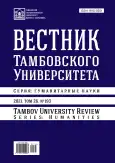Food crisis in Vienna in recent years World War I 1916–1918
- Authors: Nadirov R.A.1
-
Affiliations:
- Derzhavin Tambov State University
- Issue: Vol 26, No 193 (2021)
- Pages: 246-253
- Section: FOREIGN COUNTRIES’ HISTORY
- URL: https://ogarev-online.ru/1810-0201/article/view/298432
- DOI: https://doi.org/10.20310/1810-0201-2021-26-193-246-253
- ID: 298432
Cite item
Full Text
Abstract
The food crisis in Vienna in 1916–1918, the capital of Austria-Hungary in the last years of the First World War, is considered. It was at the final stage of the First World War that one of the most acute problems that arose in every belligerent country – food. It became impossible to ignore the deficit, which both the imperial and the city authorities tried to do in the first two years of the Great War. The scarcity of the most essential food was highlighted by such veils as endless queues in city markets, the growth of crime and child theft. By 1917, the food crisis in Vienna entered an acute phase. The main reasons for the crisis were: disruption of transport links, narrowing of cultivated areas due to the lack of male workers, procurement of food for the front, unfavorable market conditions for suppliers of agricultural products. The processes caused by martial law have led to an exorbitant rise in the cost of living, shortages, speculation on the black market. The government, in turn, did not have a specific plan to deal with an acute shortage of material resources, shortages, rising prices, but at the same time significantly limited the rights and powers of citizens. In these conditions, there was a weakening of the physical strength and morale of the urban population, which led to massive strikes and demonstrations.
Keywords
About the authors
R. A. Nadirov
Derzhavin Tambov State University
Author for correspondence.
Email: rashid-nadirov@mail.ru
ORCID iD: 0000-0002-0029-2731
Post-Graduate Student, General and Russian History Department
33 Internatsionalnaya St., Tambov 392000, Russian FederationReferences
- Pfoser A. Wohin der Krieg führt. Eine Chronologie des Zusammenbruchs. Im Epizentrum des Zusam-menbruchs. Wien im Ersten Weltkrieg. Wien, 2013, 568 S. (In German).
- Healy M. Vienna and the Fall of the Habsburg Empire: Total War and Everyday Life in World War I. Cam-bridge, 2004. 352 p.
- Healy M. Am Pranger. Auf der Suche nach den Schuldigen. Im Epizentrum des Zusammenbruchs. Wien im Ers-ten Weltkrieg. Wien, 2013. S. 294-301. (In German).
- Berger P. Die Stadt und der Krieg. Wiens Wirtschaft und Gesellschaft 1914–1918. Im Epizentrum des Zusam-menbruchs. Wien im Ersten Weltkrieg. Wien, 2013, S. 211-219. (In German).
- Davis B.J. Heimatfront. Ernährung, Politik und Frauenalltag im Ersten Weltkrieg. Heimat – Front. Militär und Geschlechterverhältnisse im Zeitalter der Weltkriege. Frankfurt, New York, 2002, S. 128-149. (In German).
- Traynin I.P. Natsional’nyye protivorechiya v Avstro-Vengrii i eye raspad [National Contradictions in Austria-Hungary and Its Disintegration]. Moscow, Academy of Sciences of the USSR Publ., 1947, 308 p. (In Russian).
- Rauchensteiner M. Der Tod des Doppeladlers. sterreich-Ungarn und der Erste Weltkrieg. Graz, Wien, Köln, 1994. (In German).
- Rauchensteiner M. Der Erste Weltkrieg und das Ende der Habsburgermonarchie 1914–1918. Wien, Köln, Weimar, 2013, 414 S. (In German).
- Banik-Schweitzer R. Anlage und Siedlungsentwicklung ab 1683. Die Stadt Wien (Österreichisches Städte-buch 7). Wien, 1999, S. 22-37. (In German).
- Langthaler E. Die Großstadt und ihr Hinterland. Im Epizentrum des Zusammenbruchs. Wien im Ersten Weltkrieg. Wien, 2013, S. 239. (In German).
- Popov G.G., Davydov S.G. «Provaly» v raspredelenii produktov i revolyutsionnyye potryaseniya 1917–1918 godov v Evrope [“Gaps” in the distribution of products and the revolutionary upheavals of 1917–1918 in Eu-rope]. Istoriko-ekonomicheskiye issledovaniya [Historical and Economic Research], 2016, vol. 17, no. 1, pp. 7-48. (In Russian).
Supplementary files









